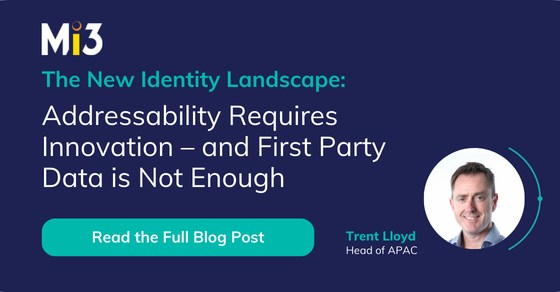The APAC digital advertising economy is expected to grow 11.6 per cent in 2024, representing the leading driver of overall advertising revenue growth of 6 per cent for the year. This expected growth exceeds previous estimates and comes on the tail of more than 8 per cent growth in 2023.
Such growth, particularly when it comes to digital channels, is well warranted, as companies look to gain a competitive edge within APAC markets. It also reveals a significant need for quality data that can help marketers maintain addressability in a privacy-first world.
In 2023, the average APAC consumer spent more than 6 hours a day online, with a greater portion of that time than ever happening on mobile devices (3 hours 44 minutes on average). While that overall time spent isn’t changing dramatically from year to year, the time spent on devices like smartphones, smart TVs, and smart watches continues to grow. These days, 91 per cent of APAC consumers are using their mobile phones as second screens while watching TV. It’s important for marketers to be able to keep pace with this ever-changing mix.
Digital advertising runs on data. And increasingly, that data is being held to a higher standard, not only in terms of consumer privacy but also in terms of how capable it is of providing cross-site and cross-platform addressability. Particularly as advertisers prepare for Google’s final deprecation of third-party cookies (now slated for next year), they need to be seeking out data and data partners that are committed to both quality and innovation. Here’s what that looks like in the new identity landscape.
Third-party data unlocks first-party potential
Today’s marketers understand that, within a privacy-first advertising landscape, first-party data is essential. But it’s also not enough. Regardless of a brand’s size or data sophistication, first-party data gathered from customer interactions tends to lack the scale and dimension needed to drive effective retention and prospecting efforts. Maintaining addressability requires deeper innovation that enables advertisers to leverage data powered by multiple IDs, including universal IDs, contextual signals, and more.
That’s where enrichment with third-party data shines. By enriching a brand’s first-party data with high-quality third-party data, brands can build a clearer picture of their customers’ wants and needs, and they can also optimize their acquisition strategies to target ads more precisely to individuals who share the characteristics of their most loyal customers.
The key to effective enrichment resides in a brand’s data and partnerships. The privacy and identity landscape has shifted significantly in the past 18 months, and brands need to seek out partners with a demonstrated investment in adapting to marketplace evolutions. Those that have weathered past data landscape upheavals, such as GDPR, and emerged stronger on the other side are the best places to start.
The future is ID-agnostic
Particularly as third-party cookies vanish from the global advertising landscape, marketers need to be ensuring their data strategies are prepared for a digital environment where no single identifier dominates. ID-agnostic solutions will be the only reliable way for brands to ensure the ability to engage their audiences consistently across digital channels.
Over the past few years, a number of universal IDs have hit the market in an effort to help the digital landscape bridge the gap being left by cookies. While these IDs will play an important role in maintaining addressability going forward, interoperability will be paramount. Solving for this fragmented identity landscape to deliver addressable media requires marketers to collaborate with data providers to use trusted audience data. Marketers should seek out data partners and solutions that operate in an ID-agnostic fashion by integrating with companies that have created identifiers to universally recognise and share information on users without cookies (e.g., ID5, UID2).
But it doesn’t stop with universal IDs. The identifiers that will power successful audience targeting solutions after the deprecation of third-party cookies will also include mobile IDs, hashed emails, contextual data, group IDs, IP addresses, and more. The strongest solutions will be the ones that recognise and leverage the unique value that each identifier and data type brings to the table. Maintaining this diversity in approach is important. For example, even if access to HEMs (hashed emails) and IP addresses is affected by future legislation, universal IDs and contextual will persist as strong post-cookie targeting solutions.
Contextual and omnichannel opportunities extend further than ever
Finally, for brands looking to evolve within the new identity landscape, it helps to look for partners and data providers that are not just trying to maintain addressability in the face of marketplace change, but rather to improve it. In many cases, this can be achieved by innovating with different types of data and channels.
For example, contextual data offers a privacy-safe and highly relevant alternative to cookie-based audiences. Contextual data and targeting, fueled by data and insights into the content people are consuming and how they’re consuming it, enables brands to connect with valuable audiences in the moments they’re engaged with topics applicable to a brand’s own products or services.
Likewise, growing channels like connected TV (CTV) and digital out-of-home (DOOH) represent channels that are ripe for innovation when it comes to data partnerships. These channels, which have never been beholden to third-party cookies, are increasingly becoming programmatic, meaning strong audience data strategies can extend into these highly engaging spaces.
The brands that emerge as leaders in the new identity landscape will be the ones that didn’t just maintain audience addressability but rather expanded it. To do so, marketers must intensify their commitment to a growing array of privacy-conscious data strategies proven to effectively engage and grow their audiences. The ideal partners for this journey are those dedicated to ensuring long-term viability, rather than those offering quick, short-term fixes.
